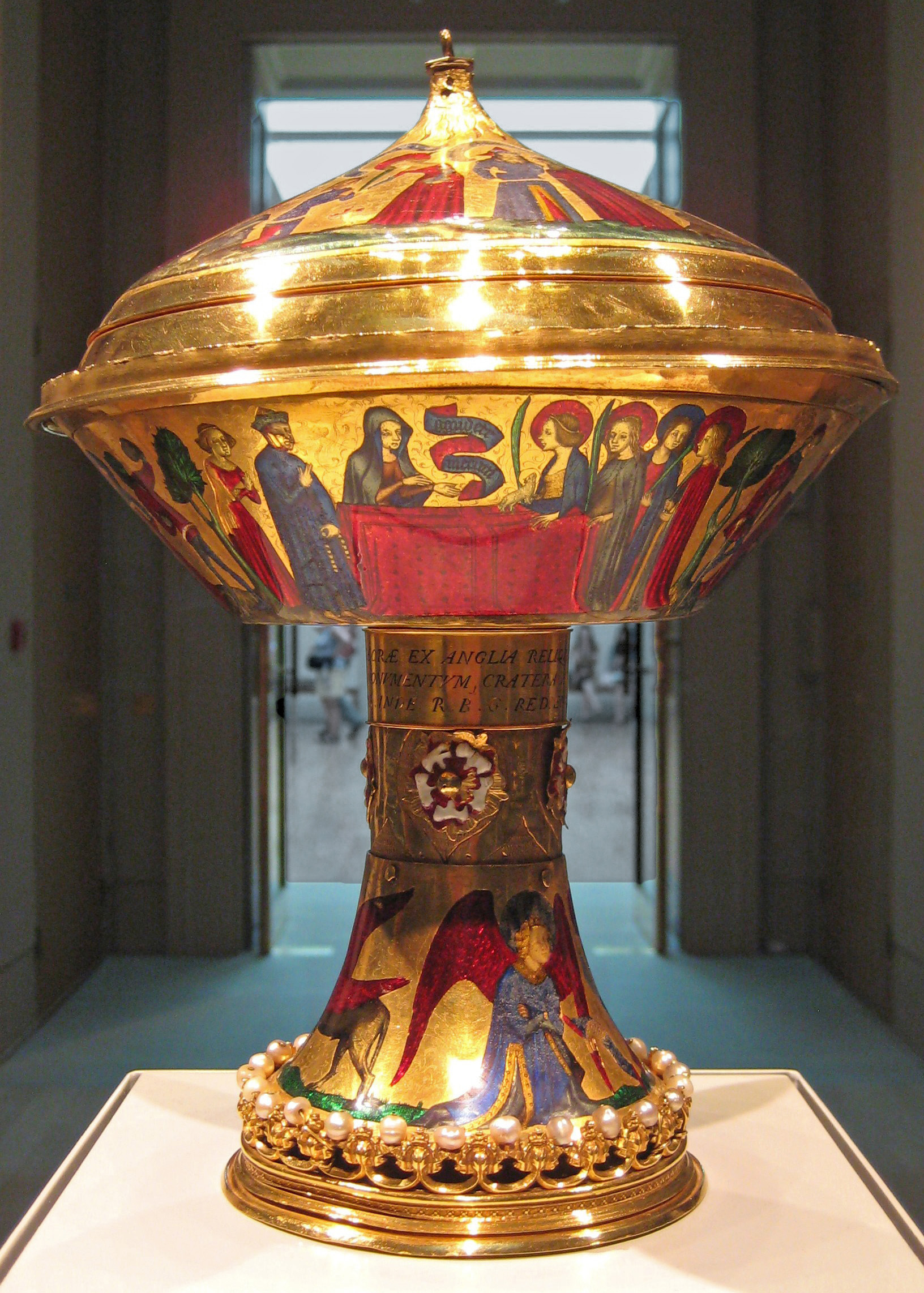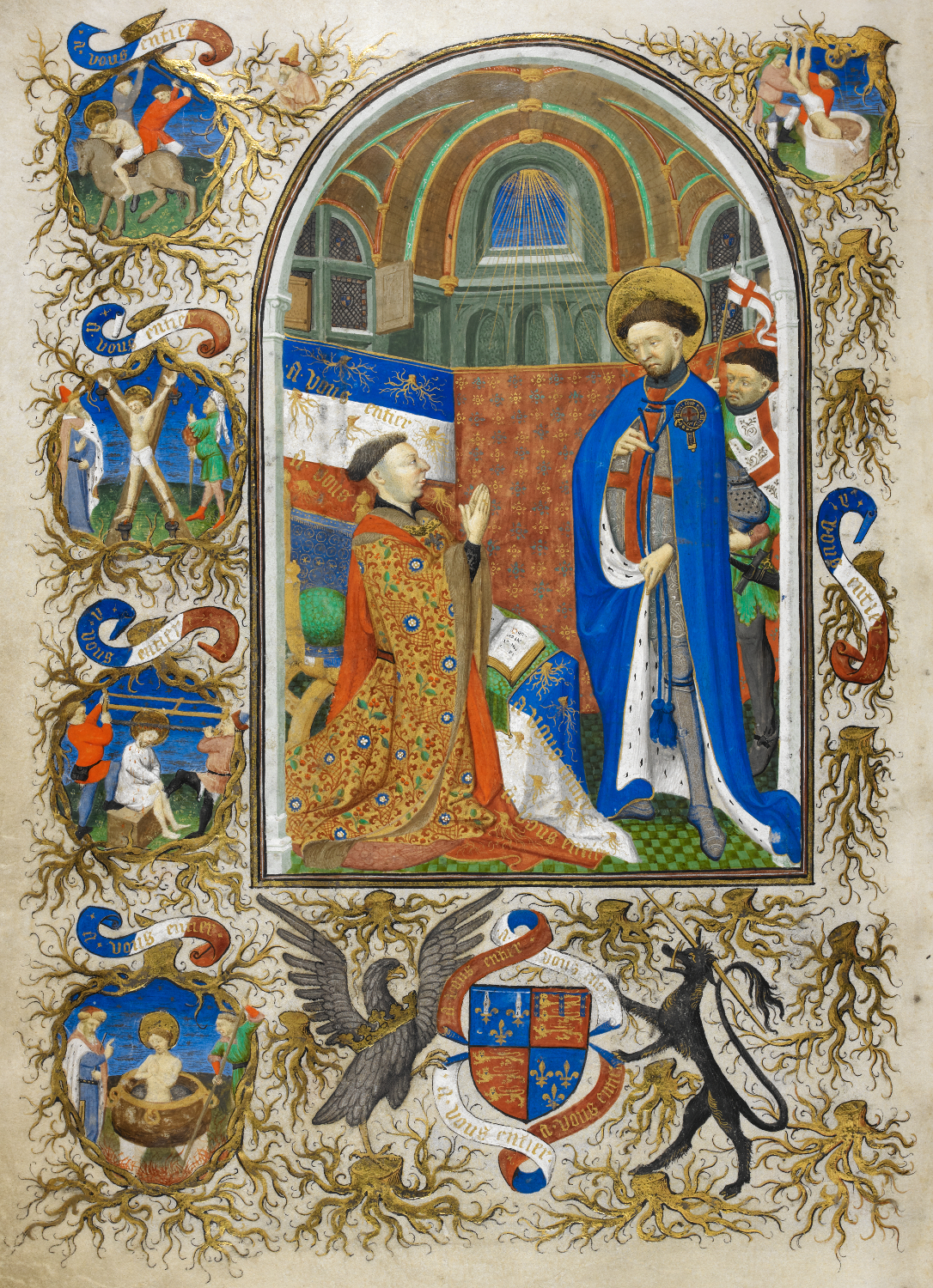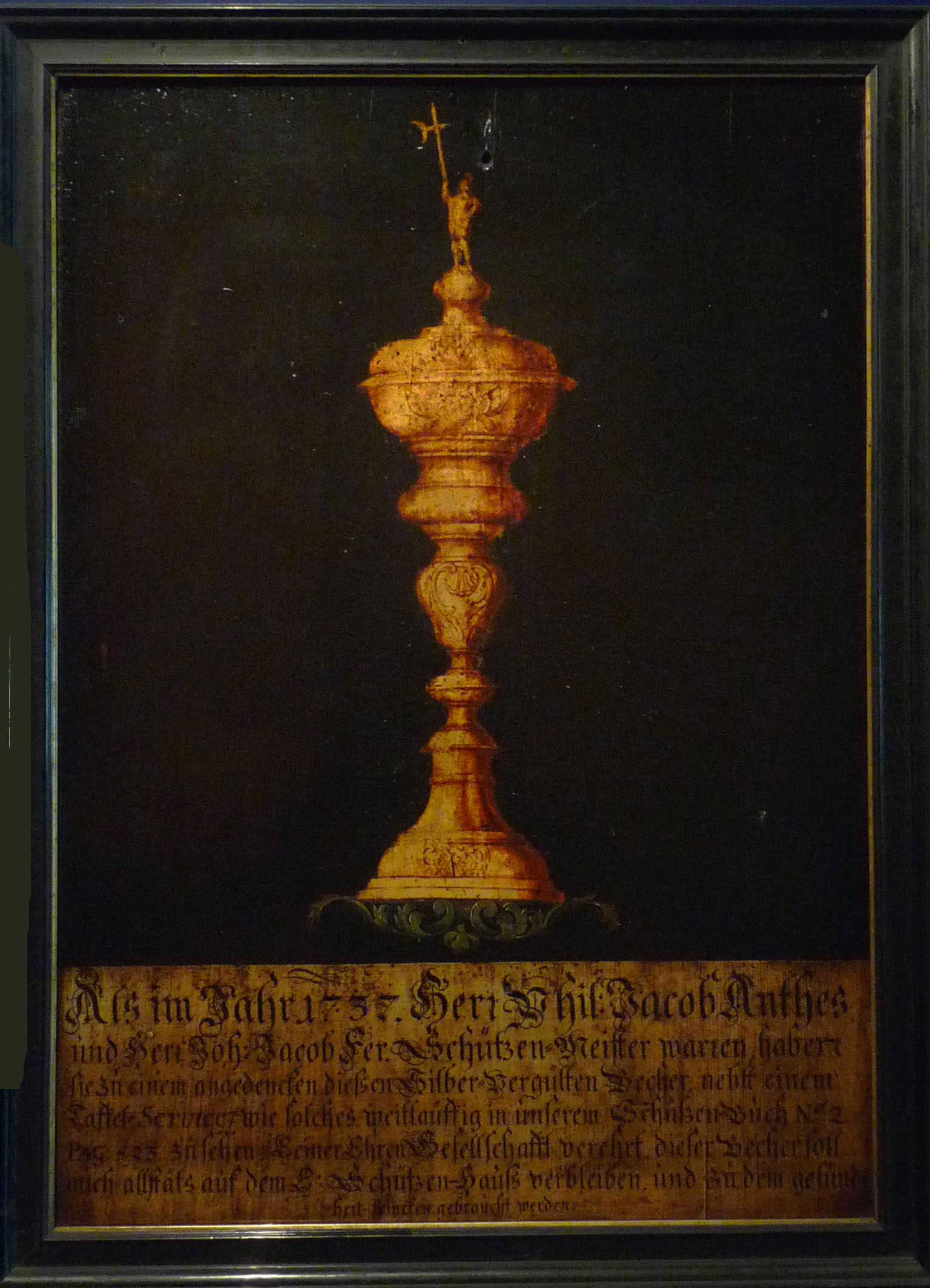|
Royal Gold Cup
The Royal Gold Cup or Saint Agnes Cup is a solid gold covered cup lavishly decorated with enamel and pearls. It was made for the French royal family at the end of the 14th century, and later belonged to several English monarchs before spending nearly 300 years in Spain. It has been in the British Museum since 1892, where it is normally on display in Room 40, and is generally agreed to be the outstanding surviving example of late medieval French plate. It has been described as "the one surviving royal magnificence of the International Gothic age". According to Thomas Hoving, former director of the Metropolitan Museum of Art in New York, "of all the princely jewels and gold that have come down to us, this is the most spectacular—and that includes the great royal treasures." The cup is made of solid gold, stands 23.6 cm (9.25 inches) high with a diameter of 17.8 cm (6.94 inches) at its widest point, and weighs 1.935 kg (4.26 lb). It has a cover that ... [...More Info...] [...Related Items...] OR: [Wikipedia] [Google] [Baidu] |
British Museum Royal Gold Cup
British may refer to: Peoples, culture, and language * British people, nationals or natives of the United Kingdom, British Overseas Territories, and Crown Dependencies. ** Britishness, the British identity and common culture * British English, the English language as spoken and written in the United Kingdom or, more broadly, throughout the British Isles * Celtic Britons, an ancient ethno-linguistic group * Brittonic languages, a branch of the Insular Celtic language family (formerly called British) ** Common Brittonic, an ancient language Other uses *''Brit(ish)'', a 2018 memoir by Afua Hirsch *People or things associated with: ** Great Britain, an island ** United Kingdom, a sovereign state ** Kingdom of Great Britain (1707–1800) ** United Kingdom of Great Britain and Ireland (1801–1922) See also * Terminology of the British Isles * Alternative names for the British * English (other) * Britannic (other) * British Isles * Brit (other) * Briton (d ... [...More Info...] [...Related Items...] OR: [Wikipedia] [Google] [Baidu] |
Henry VIII Of England
Henry VIII (28 June 149128 January 1547) was King of England from 22 April 1509 until his death in 1547. Henry is best known for his six marriages, and for his efforts to have his first marriage (to Catherine of Aragon) annulled. His disagreement with Pope Clement VII about such an annulment led Henry to initiate the English Reformation, separating the Church of England from papal authority. He appointed himself Supreme Head of the Church of England and dissolved convents and monasteries, for which he was excommunicated by the pope. Henry is also known as "the father of the Royal Navy" as he invested heavily in the navy and increased its size from a few to more than 50 ships, and established the Navy Board. Domestically, Henry is known for his radical changes to the English Constitution, ushering in the theory of the divine right of kings in opposition to papal supremacy. He also greatly expanded royal power during his reign. He frequently used charges of treason and ... [...More Info...] [...Related Items...] OR: [Wikipedia] [Google] [Baidu] |
John, Duke Of Bedford (detail) - British Library Add MS 18850 F256v
John of Lancaster, Duke of Bedford KG (20 June 138914 September 1435) was a medieval English prince, general and statesman who commanded England's armies in France during a critical phase of the Hundred Years' War. Bedford was the third son of King Henry IV of England, brother to Henry V, and acted as regent of France for his nephew Henry VI. Despite his military and administrative talent, the situation in France had severely deteriorated by the time of his death. Bedford was a capable administrator and soldier, and his effective management of the war brought the English to the height of their power in France. However, difficulties mounted after the arrival of Joan of Arc, and his efforts were further thwarted by political divisions at home and the wavering of England's key ally, Duke Philip of Burgundy and his faction, the Burgundians. In the last years of Bedford's life, the conflict devolved into a war of attrition, and he became increasingly unable to gather the necessary ... [...More Info...] [...Related Items...] OR: [Wikipedia] [Google] [Baidu] |
Gram
The gram (originally gramme; SI unit symbol g) is a Physical unit, unit of mass in the International System of Units (SI) equal to one one thousandth of a kilogram. Originally defined as of 1795 as "the absolute weight of a volume of pure water equal to Cube (algebra), the cube of the hundredth part of a metre [1 Cubic centimetre, cm3], and at Melting point of water, the temperature of Melting point, melting ice", the defining temperature (~0 °C) was later changed to 4 °C, the temperature of maximum density of water. However, by the late 19th century, there was an effort to make the Base unit (measurement), base unit the kilogram and the gram a derived unit. In 1960, the new International System of Units defined a ''gram'' as one one-thousandth of a kilogram (i.e., one gram is Scientific notation, 1×10−3 kg). The kilogram, 2019 redefinition of the SI base units, as of 2019, is defined by the International Bureau of Weights and Measures from the fixed numeric ... [...More Info...] [...Related Items...] OR: [Wikipedia] [Google] [Baidu] |
Touraine
Touraine (; ) is one of the traditional provinces of France. Its capital was Tours. During the political reorganization of French territory in 1790, Touraine was divided between the departments of Indre-et-Loire, :Loir-et-Cher, Indre and Vienne. Geography Traversed by the river Loire and its tributaries the Cher, the Indre and the Vienne, Touraine makes up a part of the western Paris Basin. It is well known for its viticulture. The TGV high-speed train system, which connects Tours with Paris (200 kilometers away) in just over an hour, has made Touraine a place of residence for people who work in the French capital but seek a different quality of life. History Touraine takes its name from a Celtic tribe called the Turones, who inhabited the region about two thousand years ago. In 1044, the control of Touraine was given to the Angevins, who (as the House of Plantagenet) became kings of England in 1154, the castle of Chinon being their greatest stronghold. In 1205, Phi ... [...More Info...] [...Related Items...] OR: [Wikipedia] [Google] [Baidu] |
Virgin Mary
Mary; arc, ܡܪܝܡ, translit=Mariam; ar, مريم, translit=Maryam; grc, Μαρία, translit=María; la, Maria; cop, Ⲙⲁⲣⲓⲁ, translit=Maria was a first-century Jewish woman of Nazareth, the wife of Joseph and the mother of Jesus. She is a central figure of Christianity, venerated under various titles such as virgin or queen, many of them mentioned in the Litany of Loreto. The Eastern and Oriental Orthodox, Church of the East, Catholic, Anglican, and Lutheran churches believe that Mary, as mother of Jesus, is the Mother of God. Other Protestant views on Mary vary, with some holding her to have considerably lesser status. The New Testament of the Bible provides the earliest documented references to Mary by name, mainly in the canonical Gospels. She is described as a young virgin who was chosen by God to conceive Jesus through the Holy Spirit. After giving birth to Jesus in Bethlehem, she raised him in the city of Nazareth in Galilee, and was in Jerusal ... [...More Info...] [...Related Items...] OR: [Wikipedia] [Google] [Baidu] |
Mark (mass)
The Mark (from Middle High German: Marc, march, brand) is originally a medieval weight or mass unit, which supplanted the pound weight as a precious metals and coinage weight from the 11th century. The Mark is traditionally divided into 8 ounces or 16 lots. The Cologne mark corresponded to about 234 grams. Like the German systems, the French poids de marc weight system considered one "Marc" equal to 8 troy ounces. Just as the pound of 12 troy ounces (373 g) lent its name to the pound unit of currency, the mark lent its name to the mark unit of currency. Origin of the term The Etymological Dictionary of the German Language by Friedrich Kluge derives the word from the Proto-Germanic term ''marka'', "weight and value unit" (originally "division, shared"). The etymological dictionary by Wolfgang Pfeifer sees the Old High German ''marc'', "delimitation, sign", as the stem and assumes that ''marc'' originally meant "minting" (marking of a certain weight), later denoting the ing ... [...More Info...] [...Related Items...] OR: [Wikipedia] [Google] [Baidu] |
Spinel
Spinel () is the magnesium/aluminium member of the larger spinel group of minerals. It has the formula in the cubic crystal system. Its name comes from the Latin word , which means ''spine'' in reference to its pointed crystals. Properties Spinel crystallizes in the isometric system; common crystal forms are octahedra, usually twinned. It has no true cleavage, but shows an octahedral parting and a conchoidal fracture. Its hardness is 8, its specific gravity is 3.5–4.1, and it is transparent to opaque with a vitreous to dull luster. It may be colorless, but is usually various shades of red, lavender, blue, green, brown, black, or yellow. Some spinels are among the most famous gemstones; among them are the Black Prince's Ruby and the "Timur ruby" in the British Crown Jewels, and the "Côte de Bretagne", formerly from the French Crown jewels. The Samarian Spinel is the largest known spinel in the world, weighing . The transparent red spinels were called spinel-rubies or b ... [...More Info...] [...Related Items...] OR: [Wikipedia] [Google] [Baidu] |
Hanap
A hanap is an obsolete, Norman-French term for a large drinking goblet, made of precious material such as gold or silver, and used especially on state occasions. In Literature 1. Old London Silver, Its History, Its Makers and Its Marks by Montague Howard (1903) "hanap or Standing Cup (1616) Height, 25 inches At St. John's College, Cambridge A radical departure was made in the form of the standing cup of the second ..." 2. Proceedings and Ordinances of the Privy Council of England by Great Britain Privy Council, Harris Nicolas, Great Britain, Nicholas Harris Nicolas, Great Britain Record Commission, England and Wales Privy Council (1834) "Item un autre hanap dargent par tout ... It j. autre hanap dargent playne ove j. tayle entour le ..." 3. Notes and Queries by Martim de Albuquerque (1850) "The hanap frequently occurs in wills and inventories of the thirteenth, fourteenth, and fifteenth centuries. In the will of Lady Clare, 1355*,— "Je devise a ..." Resources * http://www.lex ... [...More Info...] [...Related Items...] OR: [Wikipedia] [Google] [Baidu] |
Bibliothèque Nationale De France
The Bibliothèque nationale de France (, 'National Library of France'; BnF) is the national library of France, located in Paris on two main sites known respectively as ''Richelieu'' and ''François-Mitterrand''. It is the national repository of all that is published in France. Some of its extensive collections, including books and manuscripts but also precious objects and artworks, are on display at the BnF Museum (formerly known as the ) on the Richelieu site. The National Library of France is a public establishment under the supervision of the Ministry of Culture. Its mission is to constitute collections, especially the copies of works published in France that must, by law, be deposited there, conserve them, and make them available to the public. It produces a reference catalogue, cooperates with other national and international establishments, and participates in research programs. History The National Library of France traces its origin to the royal library founded at t ... [...More Info...] [...Related Items...] OR: [Wikipedia] [Google] [Baidu] |
Charles VI Of France
Charles VI (3 December 136821 October 1422), nicknamed the Beloved (french: le Bien-Aimé) and later the Mad (french: le Fol or ''le Fou''), was King of France from 1380 until his death in 1422. He is known for his mental illness and psychotic episodes that plagued him throughout his life. He ascended the throne at the young age of eleven, his father leaving behind a favorable military situation, marked by the reconquest of most of the English possessions in France. First placed under the regency of his uncles, the Dukes of Burgundy, Anjou, Berry, and Bourbon, Charles decided in 1388, aged 20, to emancipate himself. In 1392, while leading a military expedition against the Duchy of Brittany, the king had his first attack of delirium, during which he attacked his own men in the forest of Le Mans. A few months later, following the Bal des Ardents (January 1393) where he narrowly escaped death from burning, Charles was again placed under the regency of his uncles, the dukes of Berry ... [...More Info...] [...Related Items...] OR: [Wikipedia] [Google] [Baidu] |



.jpg)




